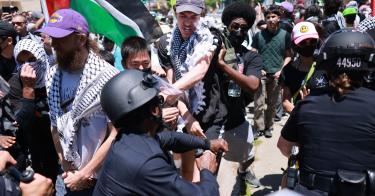Think the violent mob that called for a bloody revolution at a Los Angeles synagogue on Sunday was just a grassroots movement that coalesced spontaneously?
Think again.
The protesters are being generously funded and expertly coached by the same anti-U.S., anti-capitalist, anti-West puppet-masters who sprang Black Lives Matter on us a decade ago.
It’s all part of a giant web, a revolutionary ecosystem, that spans the globe from Havana to Shanghai and coordinates and sustains these often-violent, always-threatening protests.
These and other findings are included in a special reportthat Mary Mobley and I published this week at the Heritage Foundation.
In it, we break down the revolutionary ecosystem into four interrelated components:
- The activist organizations that plan and carry out the protests.
- The fiscal sponsors that give these organizations legal coverage and afford them opaqueness.
- The often deep-pocketed donors that fund the activist organizations through the fiscal sponsors.
- Radical media groups that amplify the protests and promote them on social media, and also routinely air propaganda for U.S. adversaries such as China, Cuba, or Russia.
Well-known examples of the activist groups we examine are American Muslims for Palestine (AMP); Students for Justice in Palestine (SJP); the Palestinian Youth Movement; Codepink; The People’s Forum; and the Act Now to Stop War & End Racism (ANSWER) Coalition.
The violent protesters that surrounded the Adas Torah Synagogue on Sunday, attacking congregants trying to enter, was organized, for example, by Codepink and the Palestinian Youth Movement, groups that are fiscally sponsored and funded by the ecosystem.
>>> How the Revolutionary Ecosystem Sustains Pro-Palestinian Protesters and the BLM Movement
Among the fiscal sponsors discuss are the Alliance for Global Justice; the Tides Foundation; the Westchester Peace Action Committee (WESPAC); the Common Counsel Foundation; Thousand Currents, etc. The donors are also well-known: George Soros’s Open Society foundations: the Rockefeller Brothers Fund, Grassroots International, etc.
The radical media groups we examine are somewhat less well known: BT Media; Common Dreams; the Grayzone; and Tricontinental.
“Social justice" in the U.S. and the political map of the Middle East are unconnected issues, but as we demonstrate, the vast majority of these organizations have coordinated protests for BLM, just as they have done for the pro-Hamas protests. Or they have fiscally sponsored groups in both movements, donated millions to them, or amplified their message on social media.
With BLM, many of them were there from the beginning, participating in some form in the formative riots that took place in Ferguson, Missouri in 2014, and in the George Floyd riots of 2020.
None of the donors, sponsors or media groups in the ecosystem focus exclusively on race, or the Middle East for that matter. “Rather, they opportunistically seize on these concerns when they arise in the news to pursue a long-term agenda that is often openly anti-capitalist and anti-democracy,” as we say in our report.
It is in this context that we must understand what AMP leader Osama Abu Irshaid meant when he told the encampment at George Washington University in April, “Israel is only another structure in an imperial project … we are going to take back America,” or when an activist for the ANSWER Coalition said at a protest in March that the goal of the protests was “getting rid of America, getting rid of the West.”
It is also not a concern about the oppression of Muslims that drives their pro-Hamas efforts. The media outlets and their officials routinely ignore or even deny the genocide of Muslim Uyghurs in China’s Xinjiang province, an outrage that somehow has failed to capture campus attention.
Given how deeply BLM has transformed our culture—not for the better, we would argue—this ecosystem should interest our policymakers. And if that doesn’t get their attention, then maybe the involvement of China, Cuba and Venezuela might.
Americans have not put pressure on their leaders to act because the media ignores the ecosystem and presents the protests as spontaneous outpourings of support for these causes. We saw this before. Google the words “racial reckoning” and you will get over 300,000 results. When you Google “national reckoning,” the results go up to 650,000.
In his May 19 speech to the graduating class of Morehouse College, President Joe Biden repeated again the hackneyed phrase “racial reckoning.”
It’s a reckoning that at least includes Chinese characteristics and Cuban rhythms. According to several sources, including a very good study by the Network Contagion and Research Institute (NCRI), many of the groups in the ecosystem have been financed from capital originally donated from Shanghai-based Neville Roy Singham.
>>> The Battle Over DEI Is Far From Over
The NCRI report describes Singham and his wife, Jodie Evans, co-founder of the activist group Codepink, as “a power couple within the global far-left movement with close ties to the CCP,” or the Chinese Communist Party.
On the fateful night of April 30, hours before protesters violently occupied Columbia’s Hamilton Hall, the protestors gathered at the Singham-funded People’s Forum’s offices in midtown Manhattan for breakout sessions on “resistance.”
There, the group’s leader Manolo de los Santos gave a Castro-style rant in which he urged the protesters to repeat the riots of 2020. He added, “make it untenable for the politics of usual to take place in this country.”
De los Santos had earlier posted on Instagram, “When we defeat Israel and the U.S. Empire, we will…know how to dismantle capitalism here in the United States.”
Where did he learn to speak that way? De los Santos has been training in Cuba for years, taking BLM groups and other radicals to the communist-run island.
None of what we have seen has been spontaneous. Like BLM, it’s all well-manicured leftist AstroTurf.
This piece originally appeared in Fox News





